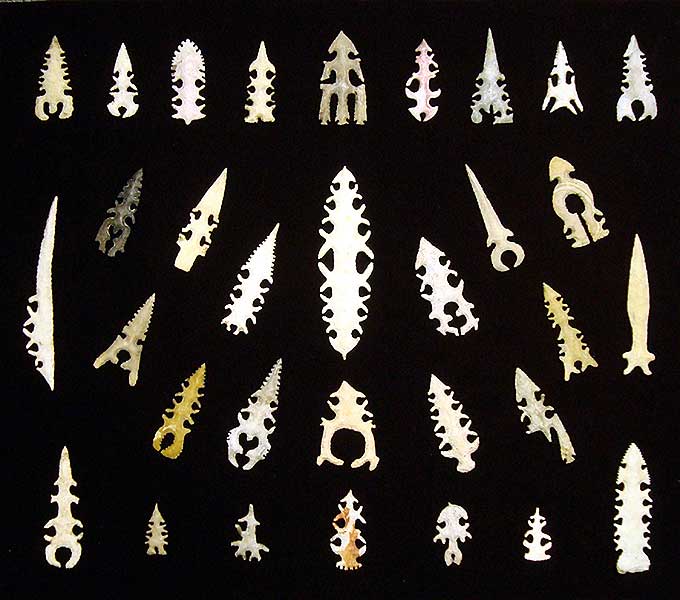 Photo 1
Photo 1
Original layout with black velvet.
In a recent framing project thirty-two arrowheads needed to be removed from a black velvet lined shadowbox (photo 1), cleaned, rearranged and re-adhered to a new neutral colored crème silk backing to match three previously completed boxes in the collection. The original gold leaf frame was cleaned, corners repaired and acrylic glazing was replaced with museum glass. Two adhesives had been used in the original mounting, which appeared to be hide glue and a PVA (polyvinyl acetate) more commonly called white glue.
 Photo 1
Photo 1
Original layout with black velvet.
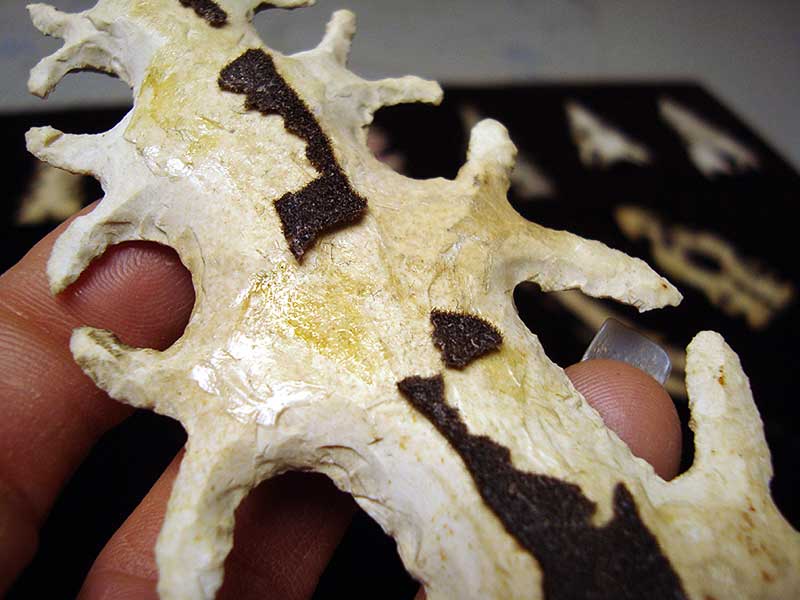 Photo 2
Photo 2
Thin, brittle hide glue coated the back of some heads.
Most of the removed heads had pieces of rotten velvet still adhered to them so they were soaked, hoping water would be the solvent. A thin layer of yellow-brown adhesive—probably hide glue—was what had mounted several of the heads leaving a brittle film that was not water-soluble (photo 2), while the white glue did soften (photo 3). A sharpened bamboo knife was used to scrap remaining fabric from the back of the heads because its slightly pliable sharpened edge would not damage the stone (photo 4). Once cleaned and dry they were realigned to form chevron lines and rearranged to better match similar carved shapes left and right. In previous shadowboxes in this series, hide glue had been used to mount trimmed pieces of color matched felt to the back of each head then each was mounted with same adhesive to a silk backing. In this case, since most were with white glue a water-soluble PVA would be sought.
 Photo 3
Photo 3
Soaked fabric and white glue.
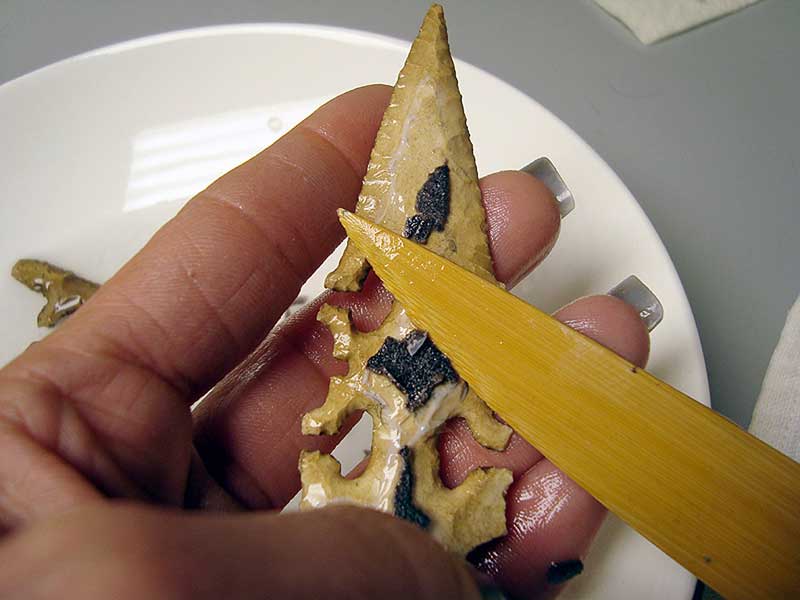 Photo 4
Photo 4
Softened glue is scraped with a bamboo knife.
Hide Glue
Hide Glue—as designated by it's name—is made from animal products. It is perfect for cabinetmaking, furniture and wood instruments, does not creep and stands the test of time. It dates back over 4,000 years to Egyptians who used it on furniture for the pharaohs. Dry hide glue needs to be cooked to prepare, similar to starch paste, but TitebondLiquid Hide Glue is available premixed and bottled. Unlike traditional hide glues, this is a one-step product which shares many of the characteristics of regular hide glue—relatively long setting time, non-creeping grip and is designed for use with porous materials—but once opened it does not have a long shelf life.
Hide glue can be reactivated—softened—for removal with a combination of heat and moisture as long as the item is not harmed by either of those elements. Hide glue's dependable strength and durability made it a choice for making fine furniture for centuries. While it has been largely displaced in the furniture industry by PVA glues, it is still used today by guitar and violin makers. One of its chief advantages over modern glues for instrument-making is the ability to unglue the joints of an instrument for repair, though its sensitivity to moisture can cause wood glued items stored in damp locations to begin to delaminate—fall apart.
For total adhesive removal once item has been removed from the backing it must be soaked in a small amount of 160ºF hot water two to four minutes, depending on thickness of the glue. After soaking immediately scrub the soaked surface with a stiff-bristle brush, then remove loose glue with a clean, damp rag and repeat steps until surface is free of glue. Remove final traces of hide glue by wiping the surface with a clean rag soaked in vinegar. All hide glue was removed from the arrowheads in preparation for rebonding.
Testing PVA
To select the correct PVA, scraps of silk were wet/dry mounted to sample boards—to replicate the silk and board used in the actual backing—so assorted glues could be tested for strength and reversibility. Thermoplastic polymer adhesives may be reactivated by water as a solvent, while thermosetting polymer adhesives are only removable by chemical solvents, rendering them non-reversible. Though many PVAs reactivate by the application of heat—such as Frank's Fabric Glue, Mighty Muck, and Miracle Muck—they are permanent when dry. Lineco Neutral pH Adhesive, is reversible but too thin for this project and soaked through the felt.
I conferred with Hugh Phibbs who recommended EVA rather than PVA. PVA stands for polyvinyl acetate, EVA stands for ethylene vinyl acetate, both of which are very broad classifications of adhesive. There are thousands of different formulations of PVAs and EVAs on the market, all of which have distinct properties with respect to viscosity, drying times, dry film characteristics, etc. Therefore, it is critical to research products by type and manufacturer when choosing a wet adhesive for any specific project.
Polyvinyl Acetate (PVA)
Basic PVA is probably the most common adhesive on the market, with most familiar brands being ®Elmers and ®Titebond. It has good wood to wood bonding and cleans up with water, but requires the pressure of clamping until cured for maximum bond. It is designed to work on porous materials, is pH neutral, fast setting and may remain flexible with age. It is a rubbery synthetic vinyl polymer adhesive component of a widely-used type of liquid vinyl resin glue, referred to variously as wood glue, white glue, carpenter's glue, school glue, wet glue or PVA glue. Traditional wood glues theywill not adhere strongly or consistently to nonporous materials, such as metal or plastic, and do not stick well to other glues, including hide glue. Conservation grade PVAs are often permanent when dry, but can still absorb water if submerged or exposed to constant humidity.
As far as PVA goes, Jade 403 sets the standard for bookbinding as a general purpose, pH neutral, acid-free, resin based, thermoplastic adhesive which is fast drying, water-soluble when wet, and permanent when dry. It is sought after for its strength, flexibility, and long term stability to not yellow or become brittle over time. It is commonly used for book and box making applications, adhering paper to paper, cloth to wood or leather, filling in cracks in art canvases and repairing ceramic objects. It holds firmly to plastic materials, and can be used on vellum…not that vellum documents should ever be glued down.
Ethylene Vinyl Acetate (EVA)
On the other hand, EVAs are a copolymer of ethylene and vinyl acetate commonly formulated into water reversible formulations. They maintain softness and flexibility, clarity and gloss, barrier properties, low-temperature toughness, and resistance to UV radiation. They are often used in packaging, textile, bookbinding and for bonding non-porous surfaces such as plastic films and metal surfaces.
Jade R is a reversible EVA, that is an acid-free, archival adhesive which provides a very strong bond similar to Jade 403 but is water-reversible after it has dried. Ideal for conservation work where reversibility is a concern, it is excellent for bonding paper, board, fabric, canvas, leather and films to other like surfaces. Evacon R is another conservation grade, water-soluble, non-plasticized EVA used for fusing papers and boards, box and envelope making, and bookbinding applications. It is a mild smelling white liquid with a pH 7-8. This one was recommended by Hugh as the reversible wet glue solution to my bonding stone to fabric.
Beva Gel is a mixture of water-soluble EVA and acrylic resins, fairly thick in viscosity compared to Jade R. The Beva line was designed for relining and painting conservation, as an excellent adhesive which bonds to a wide range of surfaces and also heat bonds at low 150º-160ºF temperatures when dry. Beva products are permanent thermosetting adhesives thatrequire toluene, xylene, isopropyl alcohol or ethanol as solvents.
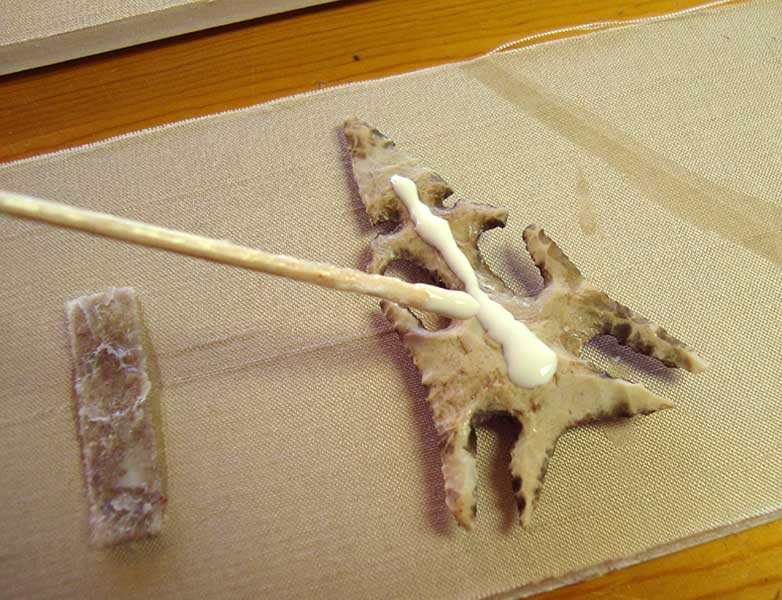 Photo 5
Photo 5
Jade R—an EVA—applied to head, soaked felt tester on the left.
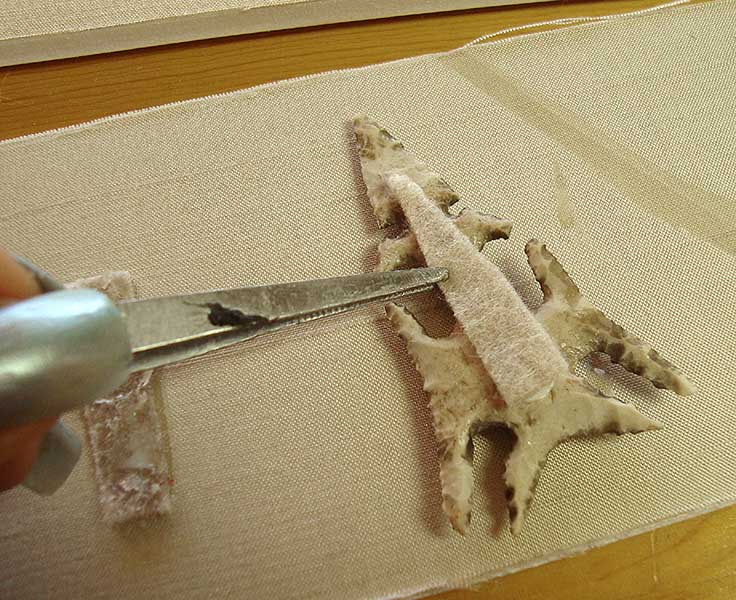 Photo 6
Photo 6
After applying Jade R the shaped felt was added.
Mounting Preparation
Though many were tested, Jade R was the perfect EVA solution. It dried fast, held well while maintaining a flexibility, did not soak through the felt and proved to be reversible with water once dry.After applying Jade R to the arrowhead (photo 5), each stone arrowhead was fitted with a strip of polyester felt that to serve as a shock absorber and buffer between the rigid covered substrate and the stone arrowhead. This also lifted each arrowhead slightly allowing it to visually float above the backing. The shaped piece of felt was aligned and lightly pressed to saturate (photo 6), then the head was turned over to allow the weight of the stone to assist in providing light pressure during drying. After 24 hours the glued felt was trimmed to eliminate visibility from the front (photo 7). All dried felts were again checked for bond strength by sheer and T-peel test, then pieces were placed into their new arrangement on the mounted silk backing board.
 Photo 7
Photo 7
Felt was trimmed so not seen from front.
 Photo 8
Photo 8
Museum glass fitted into frame as frame is suspended over backing to verify depth and visual alignment prior to final fitting.
Alignment was verified, measured for vertical and horizontal placement and all heads were checked for balance with small pieces of felt glued to unbalanced or unsupported areas. Visual sightlines were checked to verify no felt was distractingly visible and the arrangement was fused into place with a bead line of Jade R EVA. Museum glass was cut and fitted into the frame with 3/16" silk covered foam board strips used as glazing holder and spacer between the glass and the backing (photo 8). The backing in the photo has not yet been fitted flush to the bottom of the spacers, hence the ¼" gap between backing and spacers. All arrowheads are preservationally mounted with EVA, are water-reversible if removal ever become necessary and the refreshed project now matches the rest of the set (photo 9).
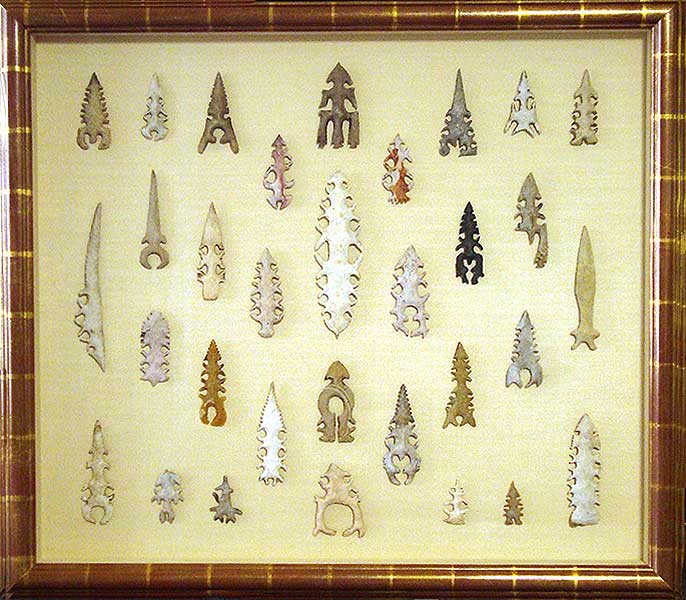 Photo 9
Photo 9
New layout with crème silk.
Bottom line…not all PVAs and EVAs are created equal. Know what you need, the porosity level of your items, what glues may have held them in place before, and then do your research homework by selecting the correct adhesive for the job.
END
Copyright © 2012 Chris A Paschke
For more articles on mounting basics look under the mounting section in Articles by Subject.
Additional information on all types of mounting is found in:
The Mounting and Laminating Handbook, Second Edition, 2002,
The Mounting And Laminating Handbook, Third Edition, 2008 and
Creative Mounting, Wrapping, And Laminating, 2000 will teach you everything you need to know about getting the most from your dry mount equipment and materials as an innovative frame designer.
All books are available from Designs Ink Publishing through this website.
Chris A Paschke, CPF GCF
Designs Ink
Designs Ink Publishing
785 Tucker Road, Suite G-183
Tehachapi, CA 93561
P 661-821-2188
chris@designsinkart.com